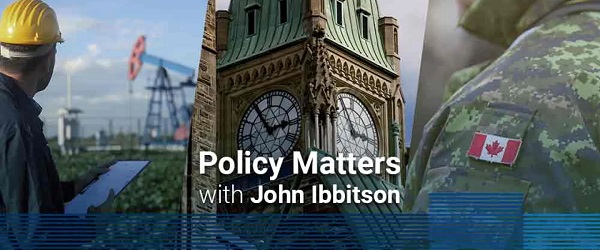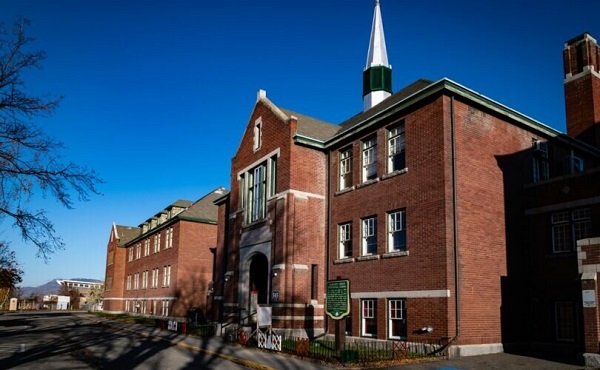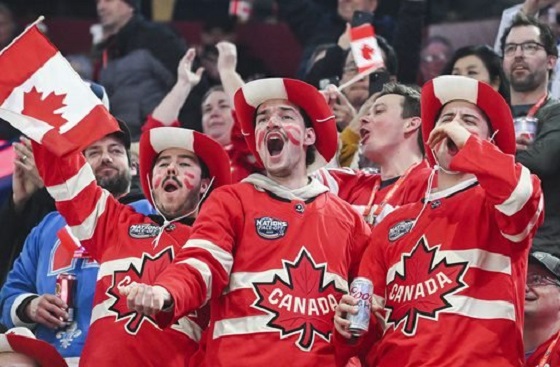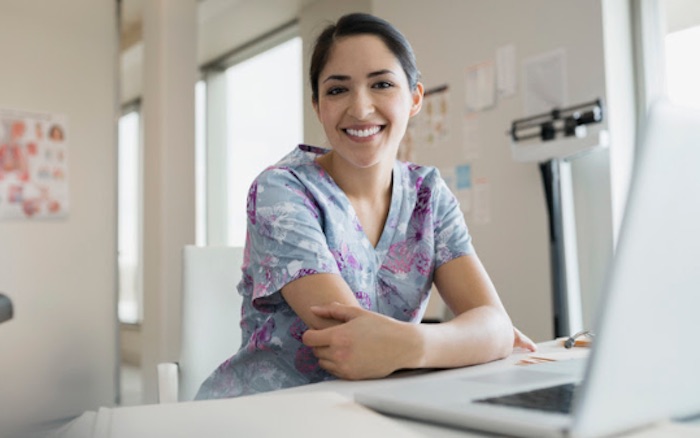Energy
A federally guaranteed Indigenous loan program is reconciliation progress, but only if it respects Indigenous agency

Roger Marten, right, Chief of Cold Lake First Nations, and Curtis Monias, centre, Chief of Heart Lake First Nation, speak after Cenovus CEO Alex Pourbaix announces an initiative focused on Indigenous communities. Photo from The Canadian Press.
From EnergyNow.ca
Indigenous communities are increasingly becoming partners and owners in major natural resource projects across the country.
Resource Works has been excited to be involved in that movement through our annual Indigenous Partnerships Success Showcase, where we convene Indigenous experts to discuss Indigenous partnerships in major projects and across the Canadian economy.
Under a proposed federal program, even more, Indigenous communities could become partners and even owners in major natural resource projects, from oil to natural gas and liquified natural gas (LNG).
Back in 2010, the proposed Northern Gateway oil pipeline from Alberta to Kitimat offered a 10% equity stake in the project to participating Indigenous groups. Yet despite having significant support, there was also considerable Indigenous opposition to the project. Ultimately, the project was killed when Prime Minister Trudeau banned oil tanker traffic on BC’s northern coast.
Fast forward twelve years, and the Coastal GasLink (CGL) natural gas pipeline and the LNG Canada project are nearing completion. In fact, CGL finished laying the last of its pipe in the ground in October 2023, completing a truly herculean engineering task, the first energy pipeline to the coast in decades. Despite some Indigenous opposition, CGL has the support of the elected councils of all 20 First Nations along the route and has offered an option for First Nations to purchase a 10% equity share in the pipeline.
Coastal GasLink will feed LNG Canada, the largest private sector investment in Canadian history. That project will turn CGL’s natural gas into liquid, where it can be shipped more densely to Asia to help replace coal, especially in industrial applications, and reduce global carbon emissions.
While CGL and LNG Canada near completion, two more proposals for LNG projects in BC are coming onto the scene. A historic first, these projects are led by First Nations: the Cedar LNG project near Kitimat from the Haisla Nation and Ksi Lisims LNG in Northern BC from the Nisga’a Nation.
A third LNG project, Woodfibre LNG, was approved by the Squamish Nation in the first-ever Indigenous environmental impact review and is now beginning construction.
Indigenous involvement – and leadership – in major energy projects has arrived. Indigenous LNG is Canadian LNG, and Canadian LNG has become Indigenous LNG. This is a global first.
Beyond natural gas and LNG, the Trans Mountain oil pipeline expansion project from Alberta to Burnaby is anticipating completion in March 2024. The expansion triples the pipeline’s capacity, the only oil pipeline to Canada’s West coast.
While there has been Indigenous opposition to this project, there has also been support, including formal agreements and billions in contracting deals for Indigenous businesses during construction. In fact, several Indigenous groups are working to acquire an equity stake in the pipeline.
Historic restrictions in the Indian Act mean Indigenous peoples face enormous barriers in raising or borrowing money to finance equity partnerships. Yet the ability to purchase equity in major projects is to enter the big leagues of economic development and wealth generation.
The federal government is expected to announce a guaranteed loan program that will enable Indigenous Peoples to finally bypass these structural obstacles and purchase equity shares in resource projects. Alberta and Saskatchewan already have their own programs, and the federal government has a lot to learn from them, particularly Alberta’s Alberta Indigenous Opportunities Corporation.
Supporters of such programs point out that Ottawa, without spending a cent of taxpayers’ money, could backstop loans to Indigenous communities. It’s a low-risk mechanism and another way to support economic reconciliation.
Unfortunately, there is uncertainty about whether this federal initiative will allow all projects to be supported. There are reports that Ottawa will exclude oil and gas projects from the guaranteed-loan program, in favour of exclusively renewable and green energy projects.
Indigenous groups argue that they can make up their own minds on what to invest in.
Four Indigenous groups have told the prime minister: “This program cannot be driven by an ‘Ottawa-knows-best’ policy approach – the judgement of Indigenous Nations about projects to pursue must be respected. . . . We believe that this initiative is not only a practical step towards reconciliation but an opportunity to demonstrate Canada’s commitment to a just future for First Peoples.”
If this loan program is created, it should be up to Indigenous peoples to decide what they want to get involved in. If we are in an era of reconciliation, shouldn’t we empower Indigenous Peoples to be decision-makers?
We can do big things as a country when we partner with Indigenous peoples. But we need to ground our policies in a positive framework that builds agency.
For many Indigenous peoples, that starts with charting their own economic destiny, including in natural resources.
Margareta Dovgal is Resource Works’ Managing Director and Event Lead for the Indigenous Partnerships Success Showcase
Daily Caller
Blackouts Coming If America Continues With Biden-Era Green Frenzy, Trump Admin Warns


From the Daily Caller News Foundation
By Audrey Streb
The Department of Energy (DOE) released a new report Monday warning of impending blackouts if the United States continues to shutter power plants without adequately replacing retiring capacity.
DOE warned in its Monday report that blackouts could increase by 100% by 2030 if the U.S. continues to retire power plants without sufficient replacements, and that the electricity grid is not prepared to meet the demand of power-hungry data centers in the years to come without more reliable generation coming online quickly. The report specifically highlighted wind and solar, two resources pushed by Biden, as responsible for eroding grid stability and advised that dispatchable generation from sources like coal, oil, gas and nuclear are necessary to meet the anticipated U.S. power demand.
“This report affirms what we already know: The United States cannot afford to continue down the unstable and dangerous path of energy subtraction previous leaders pursued, forcing the closure of baseload power sources like coal and natural gas,” DOE Secretary Chris Wright said. “In the coming years, America’s reindustrialization and the AI race will require a significantly larger supply of around-the-clock, reliable, and uninterrupted power. President Trump’s administration is committed to advancing a strategy of energy addition, and supporting all forms of energy that are affordable, reliable, and secure. If we are going to keep the lights on, win the AI race, and keep electricity prices from skyrocketing, the United States must unleash American energy.”
Dear Readers:
As a nonprofit, we are dependent on the generosity of our readers.
Please consider making a small donation of any amount here.
Thank you!
All regional grid systems across the U.S. are expected to lose reliability in the coming years without the addition of more reliable power, according to the DOE’s report. The U.S. will need an additional 100 gigawatts of new peak hour supply by 2030, with data centers projected to require as much as half of this electricity, the report estimates; for reference, one gigawatt is enough to power up to one million homes.
President Donald Trump declared a national energy emergency on his first day back in the Oval Office and signed an executive order on April 8 ordering DOE to review and identify at-risk regions of the electrical grid, which the report released Monday does. In contrast, former President Joe Biden cracked down on conventional power sources like coal with stringent regulations while unleashing a gusher of subsidies for green energy developments.
Electricity demand is projected to hit a record high in the next several years, surging 25% by 2030, according to Energy Information Administration (EIA) data and a recent ICF International report. Demand was essentially static for the last several years, and skyrocketing U.S. power demand presents an “urgent need” for electricity resources, according to the North American Electric Reliability Corporation (NERC), a major grid watchdog.
Wright has also issued several emergency orders to major grid operators since April. New Orleans experienced blackouts just two days after Wright issued an emergency order on May 23 to the Midcontinent Independent System Operator (MISO), the regional grid operator covering the New Orleans area.
Alberta
Cross-Canada NGL corridor will stretch from B.C. to Ontario

Keyera Corp.’s natural gas liquids facilities in Fort Saskatchewan. Photo courtesy Keyera Corp.
From the Canadian Energy Centre
By Will Gibson
Keyera ‘Canadianizes’ natural gas liquids with $5.15 billion acquisition
Sarnia, Ont., which sits on the southern tip of Lake Huron and peers across the St. Clair River to Michigan, is a crucial energy hub for much of the eastern half of Canada and parts of the United States.
With more than 60 industrial facilities including refineries and chemical plants that produce everything from petroleum, resins, synthetic rubber, plastics, lubricants, paint, cosmetics and food additives in the southwestern Ontario city, Mayor Mike Bradley admits the ongoing dialogue about tariffs with Canada’s southern neighbour hits close to home.
So Bradley welcomed the announcement that Calgary-based Keyera Corp. will acquire the majority of Plains American Pipelines LLP’s Canadian natural gas liquids (NGL) business, creating a cross-Canada NGL corridor that includes a storage hub in Sarnia.
“As a border city, we’ve been on the frontline of the tariff wars, so we support anything that helps enhance Canadian sovereignty and jobs,” says the long-time mayor, who was first elected in 1988.
The assets in Sarnia are a key piece of the $5.15 billion transaction, which will connect natural gas liquids from the growing Montney and Duvernay plays in B.C. and Alberta to markets in central Canada and the eastern U.S. seaboard.
NGLs are hydrocarbons found within natural gas streams including ethane, propane and pentanes. They are important energy sources and used to produce a wide range of everyday items, from plastics and clothing to fuels.
Keyera CEO Dean Setoguchi cast the proposed acquisition as an act of repatriation.
“This transaction brings key NGL infrastructure under Canadian ownership, enhancing domestic energy capabilities and reinforcing Canada’s economic resilience by keeping value and decision-making closer to home,” Setoguchi told analysts in a June 17 call.
“Plains’ portfolio forms a fully integrated cross Canada NGL system connecting Western Canada supply to key demand centres across the Prairie provinces, Ontario and eastern U.S.,” he said.
“The system includes strategic hubs like Empress, Fort Saskatchewan and Sarnia – which provide a reliable source of Canadian NGL supply to extensive fractionation, storage, pipeline and logistics infrastructure.”
Martin King, RBN Energy’s managing director of North America Energy Market Analysis, sees Keyera’s ability to “Canadianize” its NGL infrastructure as improving the company’s growth prospects.
“It allows them to tap into the Duvernay and Montney, which are the fastest growing NGL plays in North America and gives them some key assets throughout the country,” said the Calgary-based analyst.
“The crown assets are probably the straddle plants in Empress, which help strip out the butane, ethane and other liquids for condensate. It also positions them well to serve the eastern half of the country.”
And that’s something welcomed in Sarnia.
“Having a Canadian source for natural gas would be our preference so we see Keyera’s acquisition as strengthening our region as an energy hub,” Bradley said.
“We are optimistic this will be good for our region in the long run.”
The acquisition is expected to close in the first quarter of 2026, pending regulatory approvals.
Meanwhile, the governments of Ontario and Alberta are joining forces to strengthen the economies of both regions, and the country, by advancing major infrastructure projects including pipelines, ports and rail.
A joint feasibility study is expected this year on how to move major private sector-led investments forward.
-

 COVID-199 hours ago
COVID-199 hours agoFDA requires new warning on mRNA COVID shots due to heart damage in young men
-

 Business7 hours ago
Business7 hours agoCarney’s new agenda faces old Canadian problems
-

 Indigenous8 hours ago
Indigenous8 hours agoInternal emails show Canadian gov’t doubted ‘mass graves’ narrative but went along with it
-

 Daily Caller4 hours ago
Daily Caller4 hours agoBlackouts Coming If America Continues With Biden-Era Green Frenzy, Trump Admin Warns
-

 Bruce Dowbiggin10 hours ago
Bruce Dowbiggin10 hours agoEau Canada! Join Us In An Inclusive New National Anthem
-

 Alberta2 days ago
Alberta2 days agoFourteen regional advisory councils will shape health care planning and delivery in Alberta
-

 Alberta2 days ago
Alberta2 days agoAlberta school boards required to meet new standards for school library materials with regard to sexual content
-

 Business2 days ago
Business2 days agoUN’s ‘Plastics Treaty’ Sports A Junk Science Wrapper




